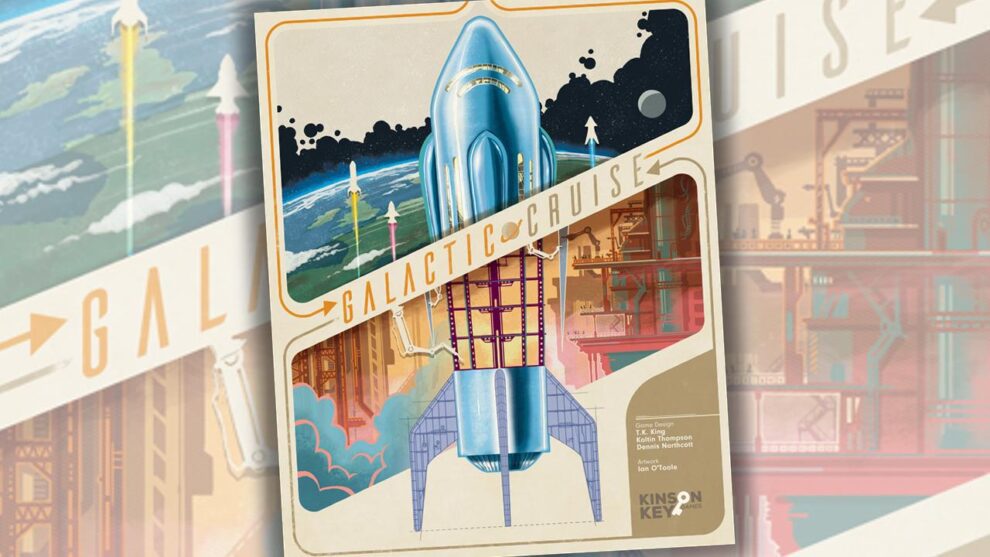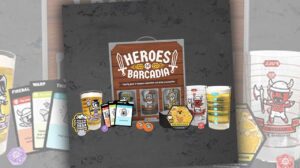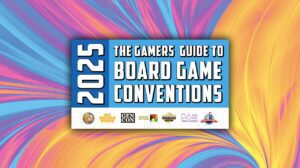Disclosure: Meeple Mountain received a free copy of this product in exchange for an honest, unbiased review. This review is not intended to be an endorsement.
Luxury Among the Stars
It has been several years since I first set eyes on Galactic Cruise back at Tantrumcon 2023. It was set up in the demo hallway, and the artwork, along with the big, chunky, colorful pieces, caught my eye. I didn’t have a chance to try it out then, but I kept seeing it pop up at most conventions I attended. If you’ve been out at any of the big tabletop conventions in the last few years, you’ve possibly passed by the game and even registered it in the back of your brain somewhere. I’ve been chomping at the bit to give it a proper spin ever since, so when a gargantuan box arrived courtesy of Kinson Key Games, I couldn’t wait to assemble my playgroup and put it through its paces.
Galactic Cruise is a worker placement and resource management game that unfolds over three distinct “eras.” I think they’re technically supposed to be “years”, but they’re variable and don’t always last the same amount of time (with the third and final era usually ending pretty abruptly), so I’m going with eras. As a supervisor in this luxury cruise line, you’ll have to build ships to satisfy guests’ needs while also marketing to the public to generate interest and invest in new technologies to keep you ahead of the curve. Each round, you’ll assign your crew members (workers) to various modules on the central board, which contains the game’s primary action spaces. Some modules give you passengers or resources, while others let you install tech upgrades, grow your reputation, or launch new cruises into outer space. Unlike many other worker placement games, you can “bump” workers off of spots to claim any place on the board, and the player who was previously blocking you gets a little boost in income as payment. It’s a twist on the mechanism that avoids the classic “locked out” problem some older worker placement games run into, seen similarly in games like Apiary.

Throughout the game, you upgrade your company board to get better resources later, gain new technologies to let you shortcut the system, and earn powerful Agenda cards that can shift your strategy. Games move at a steady pace, with the bump-and-recall system helping players avoid dead turns. Near the end of the game, as players see the finish line on the horizon, the pace can slow down to a crawl as people try to calculate the most optimal turns in advance. However, most of the games I’ve played have clocked in at just above two hours. Once you hit scoring, you tally up several different point sources, as is Euro tradition, and whoever scores the most becomes the new CEO of the company. What a promotion!
Turndown Service on Titan
Ian O’Toole is one of the best artists working in tabletop games today. His resume is essentially a “greatest hits” of modern board games, from his collaborations with Vital Lacerda to his stunning work on Voidfall and the updated version of Ra; many of his games can be found among people’s top ten lists. I had the opportunity to sit down with the team behind Galactic Cruise at Tantrumcon this year, and they spoke in depth about their collaboration with O’Toole. Many ideas for changes in mechanics and rules emerge from iterating on the artwork with Ian, where he provides suggestions on how to refine elements to flow better, be more visually apparent, and create less overhead for the player.
And the beauty of this game doesn’t stop with the artwork; all the tactile wooden pieces included are gorgeous and pop on the table. There are meeples for each player in three different varieties (workers, expert workers, and cruise consultants), plus meeples for all the passengers, and don’t forget the big wooden development cogwheels or the discs to represent your resources or the GameTrayz… or the… or the…
…I should stop myself. I could gush over the production design of this game forever because it’s clear it was all very carefully thought about ahead of time. The artwork nails a retro-futuristic minimalist aesthetic that perfectly reinforces the luxury sci-fi flair. It’s The Jetsons by way of 2001: A Space Odyssey. I love every bit of it. Almost.
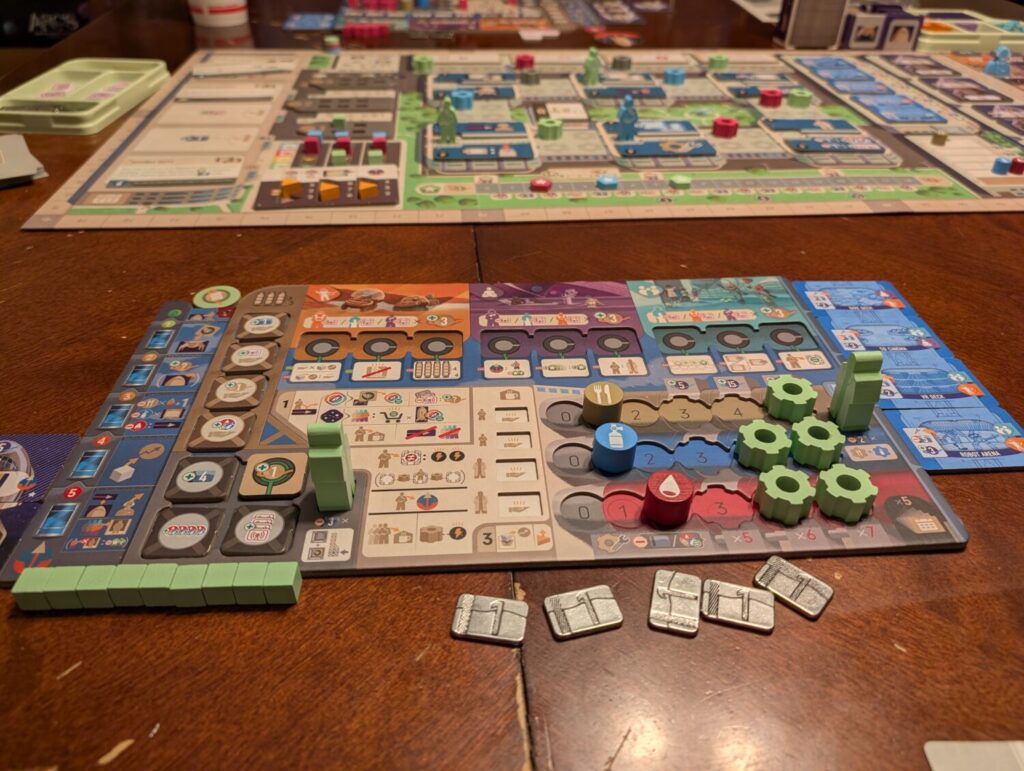
Compared to other Ian O’Toole projects, I found some of the iconography here a bit difficult to parse. Particularly, there’s a section of the player board in the bottom left that explains the steps of spending a day in space on a cruise. I have no idea why, but it’s packed to the gills with iconography for what is, in actuality, a very simple step of the turn. There’s a lot of artwork crammed into this weird, slanted section of the player board that just makes it feel overwhelming. I felt like everything else in the game flowed smoothly and was easy to understand, but I couldn’t get my head around the “day in space” rules until I looked away from the artwork and just paid attention to the rules as written.
Launch Now, Leisure Later
The player aids in this game are helpful, and I’ve found myself wishing I had them for other games as well. While playing Andromeda’s Edge just yesterday, I thought to myself, “Man, I wish I had a cheat sheet for where to get each resource in the game”. That’s something I never knew I needed, but Galactic Cruise’s “employee handbooks” are the best in the business and have set a new bar for me. Each step of a turn is laid out, and each icon is explained in detail. The front pages of the booklet feature quick reference guides to help you find the resource you’re looking for. “How do I get more fuel?” you ask yourself while finding yourself just a few dollars short of launching your next cruise.
Well, good news—you can flip to this page and discover that you get resources from taking the resource action, or purchasing supplies, or acquiring ships, or refilling the agenda row, or playing an agenda card, or just sneezing in the right direction. Okay, maybe not that last one, but it sure feels like it. I count roughly 6-10 ways to obtain each of the half dozen or so resources in the game. On the last page of this player aid, however, there’s a “pre-flight checklist” to help players understand what all needs to be done to launch a new cruise, which is, after all, the main draw of the game. And that, for me, is kind of where I fall out of love with it.
Perhaps it’s brain block around the existence of a literal checklist in the book to walk you step by step through how to take your turns optimally, or maybe it’s because of the overwhelming amount of ways to acquire each resource, but I couldn’t help but feel every game of Galactic Cruise has felt like going through the motions. There are many ways to access different resources, so most turns tend to feel like going through a checklist. Ah, so you need to get guests to launch a cruise! Guess you’d better take the “advertise for a cruise” action. However, you need to spend money on ads first, which means you must take one of the seven actions that enable you to place ads. That’s taken care of, now what? To schedule the cruise, take the “schedule a cruise” action! Don’t forget to gather resources for your cruise by taking the necessary resource actions. It all feels so paint-by-numbers that it doesn’t feel like you’re making significant decisions along the way.
Cruising in Circles
I’ve played Galactic Cruise a handful of times now, and each time I just couldn’t shake the feeling that I was jumping when the game said to jump and carrying out marching orders. I didn’t feel there was a ton of room for skill expression where I could see my risk-taking or clever planning pay off in unique, meaningful ways. I was simply selecting the best options available to me to optimize whatever resource or economic need I had at that moment. I think to myself… isn’t that just what most economic worker placement Euro games are like? Yet, I love Barrage, Terra Mystica, Ark Nova, Food Chain Magnate, and many others that might fit into this category. And that’s when it clicked.
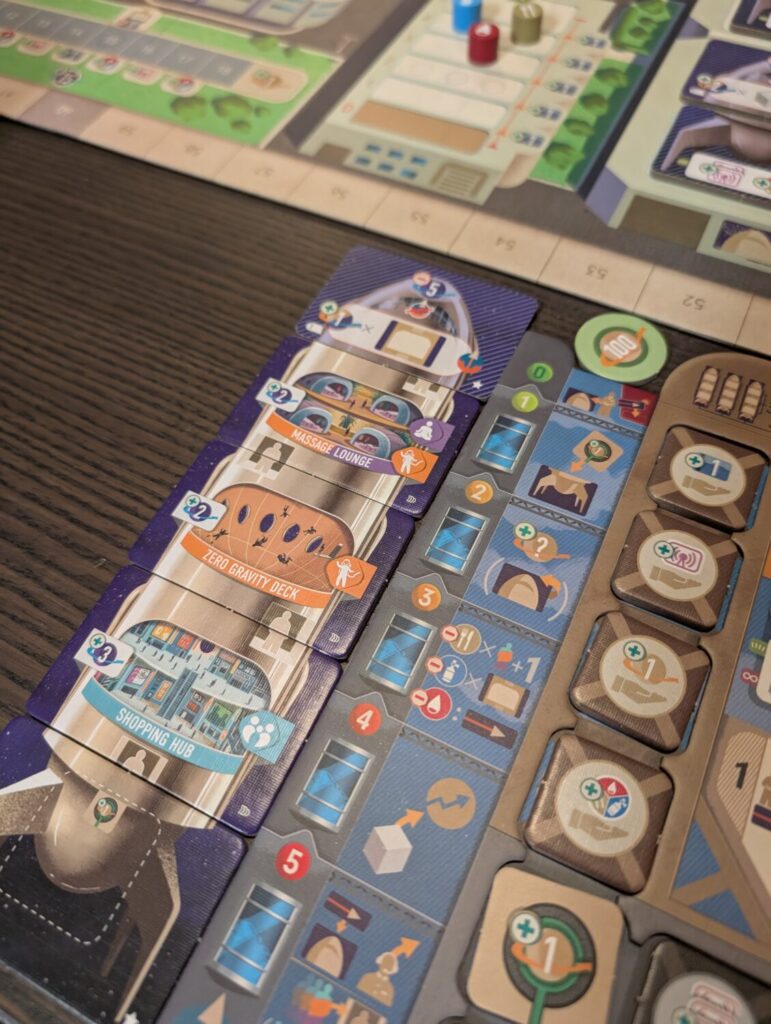
I never feel like I’m building up an economy over time in Galactic Cruise. And to its credit, the game never pretends to be that sort of experience. There’s no actual engine building—everything is in service of launching a ship, and then you’re back to square one, assembling the pieces all over again. I want to be clear: this is intentional. The game has a strong sense of identity, and it sticks to it. An engine builder, it is not. I can’t say I’ve played many other economic-style games that ask you to repeatedly reset your progress, though some of the folks I played with compared it favorably to a couple of Lacerda titles I haven’t tried (as did Justin in our First Take article) And to the game’s credit, they’re pretty enamored with Galactic Cruise.
Fair enough! This game clearly has an audience, as evidenced by the enthusiastic responses from my group and its impressive 8.5 user rating on BoardGameGeek. For me, though, the constant repetition with little sense of progression or payoff started to wear thin. There are thousands of games out there, and not all of them are suitable for everyone. Maybe Galactic Cruise is for you! Perhaps I’m just not wired for this kind of playstyle (as my consecutive losses might suggest). Clearly, people are having fun on their luxury cruise liners in the sky. But for me, it’s like everyone else boarded the ship, champagne in hand, ready for orbit—and I’m still standing at the spaceport, watching them disappear into the stars. And that’s okay. Not every ship is meant for every passenger. I’ve got my boarding pass reserved for other skyward destinations.


